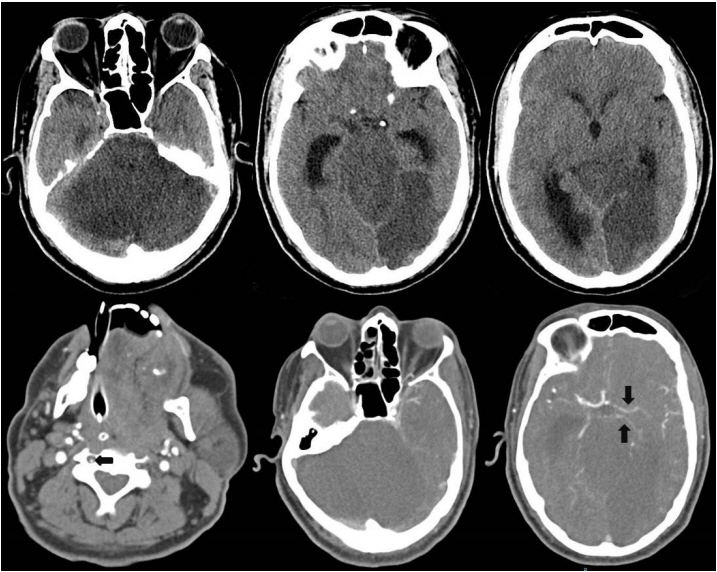J Cerebrovasc Endovasc Neurosurg.
2020 Dec;22(4):282-286. 10.7461/jcen.2020.E2020.04.001.
Unusual presentation of basilar artery thrombosis
- Affiliations
-
- 1Department of Medicine, King Abdulaziz Medical City / King Saud bin Abdulaziz University for Health Sciences, Jeddah, Saudi Arabia
- 2College of Medicine, King Abdullah International Medical Research Center / King Saud bin Abdulaziz University for Health Sciences, Jeddah, Saudi Arabia
- 3Department of Medicine, Aseer Central Hospital, Abha, Saudi Arabia
- 4College of Medicine, King Khalid University, Abha, Saudi Arabia
- KMID: 2511042
- DOI: http://doi.org/10.7461/jcen.2020.E2020.04.001
Abstract
- Strokes in the territory of the posterior cerebral artery (PCA) may rarely cause acute confusion or delirium, especially when bilateral or the dominant PCA are involved. Delirium as the only initial presentation of basilar artery thrombosis (with no brainstem or long tract findings) is an extremely rare occurrence. In this article, the clinical presentation of our case was an acute confusion with septic shock-like features (tachycardia, hypotension, and leukocytosis) for a few days without any focal deficit. These symptoms pointed more toward a non-focal neurological cause, especially meningoencephalitis. This case highlights the importance of detailed history and thorough evaluation of high-risk patients who present with an acute devastating neurological syndrome. In addition, knowledge of the atypical presentation of stroke should be acquired, and the limitation of an unenhanced computed tomography scan of the brain without vascular imaging should be known. Investigating patients with a sudden acute confusion should be directed toward the evaluation of the etiology in a stepwise manner. However, the pace of investigations should be fast to establish the diagnosis and optimize the outcome.
Keyword
Figure
Reference
-
1. Algahtani HA, Abdu AP. A comprehensive review. Neurosciences (Riyadh). 2012; Jul. 17(3):205–12.2. Ausman JI, Liebeskind DS, Gonzalez N, Saver J, Martin N, Villablanca JP, et al. A review of the diagnosis and management of vertebral basilar (posterior) circulation disease. Surg Neurol Int. 2018; 9:106.
Article3. Bonatti G, Ferro F, Haglmüller T, Pernter P, Naibo L. Basilar artery thrombosis: imaging and endovascular therapy. Radiol Med. 2010; Dec. 115(8):1219–33.
Article4. Christensen AF, Christensen H. Editorial: Imaging in Acute Stroke-New Options and State of the Art. Front Neurol. 2017; 8:736.
Article5. Demel SL, Broderick JP. Basilar occlusion syndromes: an update. Neurohospitalist. 2015; Jul. 5(3):142–50.6. Ferbert A, Brückmann H, Drummen R. Clinical features of proven basilar artery occlusion. Stroke. 1990; Aug. 21(8):1135–42.
Article7. Knap D, Kirmes T, Honkowicz M, Koroński M, Kysiak M, Bukański M, et al. Treatment of basilar artery occlusion using various techniques of interventional radiology. J Vasc Med Surg. 2016; 4(1):1–4.
Article8. Markus HS, van der Worp HB, Rothwell PM. Posterior circulation ischaemic stroke and transient ischaemic attack: diagnosis, investigation, and secondary prevention. Lancet Neurol. 2013; Oct. 12(10):989–98.
Article9. Mattle HP, Arnold M, Lindsberg PJ, Schonewille WJ, Schroth G. Basilar artery occlusion. Lancet Neurol. 2011; Nov. 10(11):1002–14.
Article10. Mortimer AM, Saunders T, Cook JL. Cross-sectional imaging for diagnosis and clinical outcome prediction of acute basilar artery thrombosis. Clin Radiol. 2011; 66(6):551–8.
Article11. Nouh A, Remke J, Ruland S. Ischemic posterior circulation stroke: a review of anatomy, clinical presentations, diagnosis, and current management. Front Neurol. 2014; Apr. 5:30.
Article12. Organek N, Milano N, Donohue M, Sundararajan S, Strbian D, Katzan IL. Significant period between presentation and diagnosis in basilar artery occlusion: five cases and the lessons learned. Stroke. 2015; Apr. 46(4):e79–81.
Article13. Schonewille WJ, Wijman CA, Michel P, Rueckert CM, Weimar C, Mattle HP, et al. Treatment and outcomes of acute basilar artery occlusion in the Basilar Artery International Cooperation Study (BASICS): a prospective registry study. Lancet Neurol. 2009; Aug. 8(8):724–30.
Article14. Schulz UG, Fischer U. Posterior circulation cerebrovascular syndromes: diagnosis and management. J Neurol Neurosurg Psychiatry. 2017; Jan. 88(1):45–53.
Article15. Setters B, Solberg LM. Delirium. Prim Care. 2017; Sep. 44(3):541–59.
Article16. Wijdicks EF, Scott JP. Outcome in patients with acute basilar artery occlusion requiring mechanical ventilation. Stroke. 1996; Aug. 27(8):1301–3.
Article
- Full Text Links
- Actions
-
Cited
- CITED
-
- Close
- Share
- Similar articles
-
- Progression of In Situ Thrombosis of Basilar Artery
- Microsurgical Anatomy of the Basilar Artery and Posterior Cerebral Artery
- Microsurgical Anatomy of the Basilar Artery: Surgical Approaches to the Basilar Trunk and Vertebrobasilar Junction Aneurysms
- Endovascular Treatment of Giant Basilar Trunk Aneurysm: Case Report
- A Case of Fenestrated Basilar Artery Associated with Multiple Aneurysms


